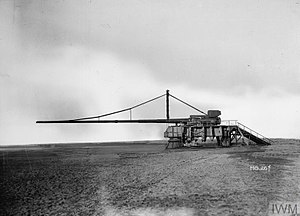This article needs additional citations for verification. (October 2023) |
| Paris Gun | |
|---|---|
 The German Paris Gun, also known as the Kaiser Wilhelm Gun, was the largest gun of World War I. In 1918, the Paris Gun shelled Paris from 120 km (75 mi) away. | |
| Type | Super heavy field gun |
| Place of origin | German Empire |
| Service history | |
| Used by | |
| Wars | World War I |
| Production history | |
| Designer | Dr. Fritz Rausenberger |
| Manufacturer | Krupp |
| Specifications | |
| Mass | 256 t (252 long tons; 282 short tons) |
| Length | 34 m (111 ft 7 in)[1]: 84 |
| Barrel length | 21 m (68 ft 11 in) |
| Caliber | 211 mm (8.3 in), later rebored to 238 mm (9.4 in) |
| Breech | horizontal sliding-block |
| Elevation | 55 degrees |
| Muzzle velocity | 1,640 m/s (5,400 ft/s) |
| Maximum firing range | 130 km (81 mi) |

The Paris Gun (German: Paris-Geschütz / Pariser Kanone) was a type of German long-range siege gun, several of which were used to bombard Paris during World War I. They were in service from March to August 1918. When the guns were first employed, Parisians believed they had been bombed by a high-altitude Zeppelin, as the sound of neither an airplane nor a gun could be heard. They were the largest pieces of artillery used during the war by barrel length, and qualify under the (later) formal definition of large-calibre artillery. Also called the "Kaiser Wilhelm Geschütz" ("Kaiser Wilhelm Gun"), they were often confused with Big Bertha, the German howitzer used against Belgian forts in the Battle of Liège in 1914; indeed, the French called them by this name as well.[Note 1][2] They were also confused with the smaller "Langer Max" (Long Max) cannon, from which they were derived. Although the famous Krupp-family artillery makers produced all these guns, the resemblance ended there.
As military weapons, the Paris Guns were not a great success: the payload was small, the barrel required frequent replacement, and the guns' accuracy was good enough for only city-sized targets. The German objective was to build a psychological weapon to attack the morale of the Parisians, not to destroy the city itself.
- ^ Bull, Gerald V.; Murphy, Charles H. (1988). Paris Kanonen: The Paris Guns (Wilhelmgeschutze) and Project HARP. Herford: E. S. Mittler. ISBN 3-8132-0304-2.
- ^ Ley, Willy (December 1961). "Dragons and Hot-Air Balloons". For Your Information. Galaxy Science Fiction. pp. 79–89.
Cite error: There are <ref group=Note> tags on this page, but the references will not show without a {{reflist|group=Note}} template (see the help page).